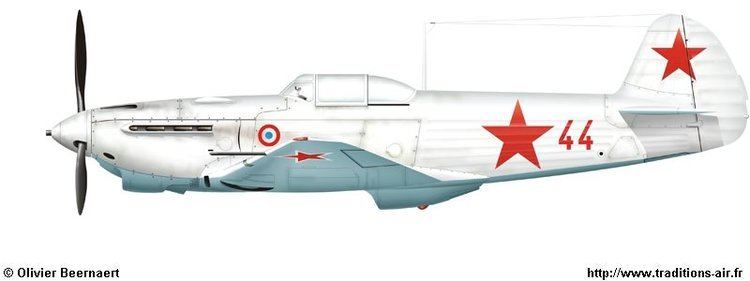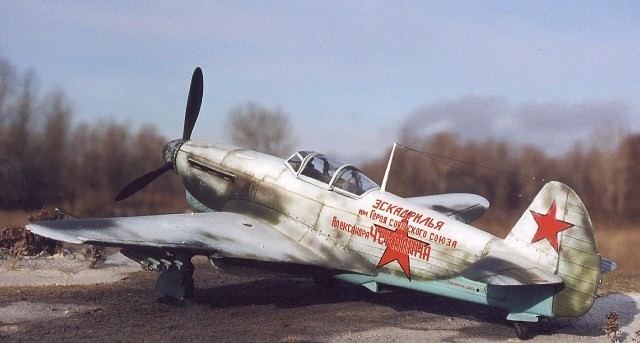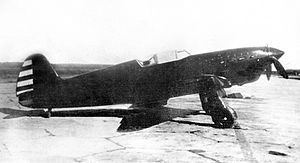Top speed 592 km/h Wingspan 10 m Number built 8,700 | Length 8.5 m Produced 1940-1944 | |
 | ||
The Yakovlev Yak-1 was a World War II Soviet fighter aircraft. Production began in early 1940. It was a single-seat monoplane with a composite structure and wooden wings.
Contents

The Yak-1 was manoeuvrable, fast and well armed, and it was easy to maintain and reliable. It formed an excellent basis for subsequent developments from the Yakovlev bureau. It was the founder of a family of aircraft, with some 37,000 being built. As a reward, designer Alexander Yakovlev was awarded the Order of Lenin (Russian: Орден Ленина, Orden Lenina) - the highest decoration bestowed by the Soviet Union - a 100,000 ruble prize, plus a Zis motor car.

Design and development

Prior to World War II, Yakovlev was best known for building light sports aircraft. His Yak-4 light bomber impressed the Soviet government enough to order the OKB to design a new fighter with a Klimov M-106 V-12 liquid-cooled engine. Formal specifications, which were released on 29 July 1939, called for two prototypes - I-26-1 with a top speed of 620 km/h (385 mph) at 6,000 m (16,685 ft), combat range of 600 km (375 mi), a climb to 10,000 m (32,808 ft) of under 11 minutes, and armament of 2 × 7.62 mm ShKAS machine guns and 1 × 12.7 mm (0.5 in) Berezin BS heavy machine gun, and I-26-2 with a turbocharged M-106 engine with a top speed of 650 km/h (404 mph) at 10,000 m (32,808 ft) and armament of 2 × 7.62 mm (.3 in) ShKAS machine guns. The design took full advantage of Yakovlev OKB's experience with sports aircraft and promised agility as well as high top speed. Since the M-106 was delayed, the design was changed to incorporate the Klimov M-105P V-12 engine, with a 20 mm (.8 in) ShVAK cannon in the "vee" of the engine block, in a motornaya pushka mount.

I-26-I first flew on 13 January 1940. The prototype suffered from oil overheating problems which were never completely resolved, resulting in 15 emergency landings during early testing. Then, on 27 April 1940, I-26-1 crashed, killing its test pilot Yu.I. Piontkovskiy. The investigation of the crash found that the pilot had performed two consecutive barrel rolls at low altitude, which was in violation of the test flight plan. It was believed that during the first roll, the main landing gear became unlocked, causing it to crash through the wing during the second roll. It has been hypothesized that Piontkovskiy's deviation from the flight plan was caused by frustration that his aircraft was being used for engine testing while I-26-2, built with the lessons of I-26-1 in mind, was already performing aerobatics.

Technical issues with sub-assemblies provided by different suppliers raised the I-26-2's weight 400 kg (882 lb) above projected figures, which restricted the airframe to only 4.4 G, while overheating oil remained a problem. The many defects caused I-26-2 to fail government testing in 1940. Fortunately for Yakovlev, its competitors, I-200 (future Mikoyan-Gurevich MiG-3) and I-301 (future LaGG-3), also failed testing. Requested improvements were incorporated into I-26-3, which was delivered for testing on 13 October 1940. Although it passed on 9 December 1940, the aircraft was still very much unfinished, with unresolved engine problems.
Troublesome and slow testing and development concerned Soviet officials, since I-26 was ordered into production under the name "Yak-1" on 19 February 1940, a mere month after I-26-1 made its maiden flight. The goal of this gamble was to reduce the lag time between the prototype and production aircraft. As backups, the I-200 and I-301 were also ordered into production. Although the Yak-1 was slower than the I-200 and less heavily armed than the I-301, it enjoyed the advantage of having been started earlier, which gave it a consistent lead in testing and development over its competitors. Due to the Axis invasion of the Soviet Union on 22 June 1941, development and implementation of several other upcoming promising designs, like the Polikarpov I-185, proved unfeasible. Yakovlev might have been Joseph Stalin's personal favorite, which may have been in the Yak-1's favor.
Simultaneous manufacturing and testing of a design that required as many improvements as I-26 wreaked havoc on the production lines. Almost 8,000 changes were made to the aircraft's blueprints by 1941, with an additional 7,000 implemented the following year, and 5,000 more changes coming in 1942. Production was further slowed by shortages of engines, propellers, radiators, wheels and cannons. Shortages of quality materials resulted in plywood being torn off the wings on several aircraft. To make matters worse, Factory No.292 which was the main manufacturer of Yak-1s was bombed on 23 June 1943 and burned to the ground. Amazingly, production resumed amid the ruins on 29 June. Due to loose tolerances, each aircraft was essentially unique, with workers performing the final assembly having the unenviable task of mating what often proved to be somewhat dissimilar components. For example, the left and right main landing gear could be of different lengths and different angles relative to the aircraft, which required adjusting their attachments to ensure an even stance for the completed aircraft. Parts were often not interchangeable between aircraft. Production of the Yak-1 ended in July 1944, with somewhere around 8,700 built.
Operational history
At the time of the German invasion of Soviet Union on 22 June 1941, 425 Yak-1s had been built, although many were en route or still disassembled. 92 machines were fully operational in the Western Military Districts, but most were lost in the very first days of the war. The Yak-1 was designed with the goal of providing direct coverage of the Il-2 attack planes from enemy fighters. Thus, most of the air combat took place below 4,000 m (13,123 ft), at low altitudes where the Yak-1 performed the best. The Yak-1 proved to have a significant advantage over its Soviet competitors. A full circle turn took just 17 seconds in the Yak-1M. The MiG-3, which had the best high-altitude performance, did poorly at low and medium altitudes, and its light armament made it unsuitable even for ground attack. The LaGG-3 experienced a significant degradation in performance (as much as 100 km/h/62 mph on some aircraft) compared to its prototypes due to the manufacturer's inexperience with its special wooden construction, which suffered from warping and rotting when exposed to the elements. The Yak-1's plywood covering also suffered from the weather, but the steel frame kept the aircraft largely intact.
The aircraft's major problem early in deployment was fuel leaks caused by failure of spot-welded fuel tanks from vibration. Also troublesome was the fact that the canopy could not be opened under certain conditions in earlier models, potentially trapping the pilot in a falling aircraft. As a result, some pilots had the sliding portion of the canopy removed altogether. The first 1,000 Yak-1s had no radios. Installation of radio equipment became common by spring 1942 and obligatory by August 1942. But Soviet radios were notoriously unreliable and short-ranged, so they were frequently removed to save weight.
Like the Rolls-Royce Merlin float carburetor-equipped engines, the M-105 could not tolerate negative G forces which starved it of fuel. Moreover, they suffered breakdowns of magnetos and speed governors and emitted oil from the reduction shaft.
The Yak-1 was better than the Bf 109E, but inferior to the Bf 109F - its main opponent - in rate of climb at all altitudes, although it could complete a circle at the same speed (20–21 seconds at 1,000 meters ). In comparison, a Bf 109, with its automatic flaps, had a lower stall speed and was more stable in sharp turns and vertical aerobatic figures. A simulated combat between a Yak (with M-105PF engine) and a Bf 109F revealed that the Messerschmitt had only marginally superior manoeuvrability at 1,000 meters (3,300 ft), though the German fighter could gain substantial advantage over the Yak-1 within four or five nose-to-tail turns. At 3,000 meters (9,800 ft), the capabilities of the two fighters were nearly equal, as combat was essentially reduced to head-on attacks. At altitudes over 5,000 meters (16,400 ft), the Yak was more manoeuvrable. The engine’s nominal speed at low altitudes was lowered to 2,550 rpm, and the superiority of the Bf 109F at these altitudes was reduced.
The Yak-1's armament would be considered too light by Western standards, but was typical of Soviet aircraft, the pilots preferring a few guns grouped on the centerline to improve accuracy and reduce weight. Wing guns were rarely used on Soviet fighters, and when they were used, they were often removed (as they were from US-supplied Bell P-39 Airacobras). Avoiding wing guns reduced weight and demonstrably improved roll rates (the same was true of the Bf 109F). The US and Britain considered heavy armament and high performance necessary, even at the cost of reduced agility, while the Soviets relied on the marksmanship of their pilots, coupled with agile aircraft. Even with the Yak-1's light armament, to reduce weight, modifications were made both on the front line and on about thirty production aircraft: the 7.62 mm ShKAS machine-guns were removed, retaining only the single ShVAK cannon. Nevertheless, these lighter aircraft were popular with experienced pilots, for whom the reduction in armament was acceptable, and combat experience in November 1942 showed a much improved kill-to-loss ratio. Also, in the autumn of 1942, the Yak-1B appeared, with the more powerful M-105P engine and a single 12.7 mm UBS machine gun instead of the two ShKAS. Although this did not increase the total weight of fire much, the UBS machine-gun was much more effective than the two 7.62 mm ShKAS. Moreover, the simple VV ring sight replaced the PBP gun-sight because of the very poor quality of the latter's lenses. The Yak-1 had a light tail, and it was easy to tip over and to hit the ground with the propeller. Often, technicians had to keep the tail down, which could lead to accidents, with aircraft taking off with technicians still on the rear fuselage.
Nonetheless, the Yak-1 was well liked by its pilots. For Soviet pilot Nikolai G. Golodnikov, overall, in its tactical and technical characteristics, the Yak-1B flown by experienced pilots could meet the Bf 109F-4 and G-2 on equal terms. French Normandie-Niemen squadron selected the primitive model Yak-1M (that had a cut-down fuselage to allow all-round vision) when it was formed, in March 1943. Twenty-four of these aircraft were sent to the elite all-female 586 IAP, whose pilots included the world's only female aces: Katya Budanova, with 11, and Lydia Litvyak (11 plus three shared). Litvyak flew Yak-1 "Yellow 44", with an aerial mast, at first in 296.IAP and then with 73.Gv.IAP, until her death in combat on 1 August 1943. Another ace who flew the Yak-1 was Mikhail Baranov, who scored all his 24 victories with it, including five on a day (four Bf 109s and one Ju 87, on 6 August 1942). The Yak-1 was also the first type operated by the 1 Pułk Lotnictwa Myśliwskiego "Warszawa" ("1st Polish Fighter Regiment 'Warsaw'").
Soviet naming conventions obscure the fact that the Yak-1 and its successors — the Yak-7, Yak-9 and Yak-3 — are essentially the same design, comparable to the numerous Spitfire or Bf 109 variants. Were the Yaks considered as one type, the 37,000 built would constitute the most produced fighter in history. That total would also make the Yak one of the most prolific aircraft in history, roughly equal to the best known Soviet ground attack type of World War II, the IL-2 Shturmovik. But losses were proportionally high, in fact the highest of all fighter types in service in the USSR: from 1941 to 1945, VVS KA lost 3,336 Yak-1s: 325 in 1941, 1,301 the following year, 1,056 in 1943, 575 in 1944 and 79 in 1945.
Variants
Operators
Specifications (Yak-1b)
General characteristics
Performance
Armament
